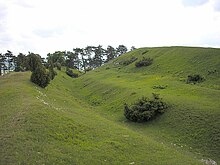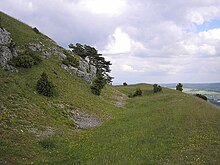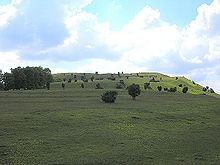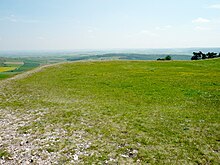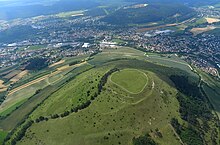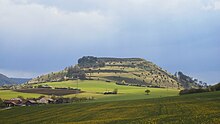Ipf
| Ipf | ||
|---|---|---|
|
The Ipf seen from the west |
||
| height | 668.2 m | |
| location | Baden-Wuerttemberg , Germany | |
| Mountains | Swabian Alb (Alb foreland) | |
| Coordinates | 48 ° 52 '14 " N , 10 ° 21' 23" E | |
|
|
||
| Type | Zeugenberg | |
The Ipf is a 668.2 m above sea level. NHN high witness mountain of the eastern Swabian Alb near Bopfingen in the Baden-Württemberg Ostalb district .
The Ipf is located directly north of Bopfingen and towers over the city by 200 meters. Except for parts of the north side, its slopes are unwooded and have heather vegetation . The distinctive conical shape of the mountain clearly distinguishes it from its surroundings.
There are mighty prehistoric fortifications on the summit plateau, which dates back to the Late Bronze Age from the 12th century BC. Were created.
geology
The Ipf consists mainly of limestones and marls from the upper South German Jura ( Weißjura ). The sequence of layers of the Weißjura is complete. The slopes gently rising to the Ipf and the foot of the mountain are made of sandstones, oolithic limestones and claystones of the higher central South German Jura ( Braunjura ), including the so-called iron sandstone and ornate clay . In the wider area of the mountain, the so-called Opalinus Clay of the lowest Braunjura (Braunjura α, Aalenium ) stands.
The difference in susceptibility to weathering and erosion between the Brown Jurassic (relatively susceptible, especially the Opalinus Clay) and the White Jurassic layers (less susceptible) is an important reason for the formation of the Ipf as a witness mountain. Characteristic here is the reinforcement of the more vulnerable Brown Jurassic layers by the carbonate rocks of the White Jurassic.
Research history
The first excavations on the Ipf were carried out by Eduard Paulus in 1869 . Until then, it was assumed that the fortifications on the mountain date from Roman times or from the Thirty Years' War. In addition to a multitude of animal bones, Paul discovered “numerous fragments of old Germanic vessels”. He was able to prove that the mountain was already inhabited in prehistoric times.
In 1907 Friedrich Hertlein carried out further excavations on the Ipf. He examined two of the ramparts and the fortification of the plateau. He also dug in various places on the plateau. For the conditions at the time, he documented and published the excavation results in an exemplary manner. During the excavations in the outermost and in the second wall, he found dry stone walls with vertical wooden fixtures in the front. He also found charred wooden beams in the massive fortifications on the edge of the plateau. Hertlein associated this construction of the walls with the similar fortification of the Heidengraben , which is referred to as fortification of an oppidum and dates back to the late Latène period.
In 1969 a reading from the Ipf was published, a black-varnished shard from an Attic drinking bowl from around 500 BC. Since then it has been discussed whether the Ipf is to be counted among the early Celtic princely seats due to this import find. In addition, due to the very good state of preservation, there was also the assumption that the ramparts could not have been built until the Middle Ages to protect against the incursions of Hungarian hordes.
New excavations in the immediate vicinity of the Ipf and on the Ipf by the State Office for Monument Preservation Baden-Württemberg since 2000 brought clarity , in which a three-phase rectangular courtyard from the late Hallstatt / Early Latency period (5th century BC) in the Gewann Zaunäcker in Kirchheim- Osterholz . Chr.), As well as the excavations 2004–2010 as part of the priority program of the DFG “Early Centralization and Urbanization Processes - for the Genesis and Development of the 'Early Celtic Princes' Seats' and their Territorial Surroundings” by Rüdiger Krause . This new research has confirmed that the Ipf had an important function as early as the Neolithic , but increasingly since the Late Bronze Age (1200–800 BC), and that it had an important function in the Late Hallstatt and Early La Tène periods (6th / 5th centuries BC) .) flourished as a supra-regional center of power and a hub in the long-distance network.
The remains of the fortifications, which are so impressively visible today, were built in the early La Tène period (end of the 5th century BC). In the Middle and Late La Tène Period, the Ipf seems to have lost its importance.
colonization
Summit plateau
As Hertlein noted, the pottery finds from the Ipf range from the Neolithic to the Roman period. In 2004, an excavation cut was made on the east side of the summit plateau within the edge fortifications . The rock was reached at a depth of 2.5 m. The cut produced an enormous amount of small finds, pottery and animal bones.
Immediately on the rock was a 0.7 m thick layer of culture from the younger Urnfield culture (Ha B). Above it lie several layers with a total thickness of one meter that date back to the Hallstatt period. The foundations of two dry stone walls, which are aligned parallel to the slope edge, are integrated into the layers of the late Hallstatt period. Stone foundations are considered unusual for the Hallstatt period. Parallels can be found on the Heuneburg .
Shards of Greek pottery were also found in the layers of the late Hallstatt period, two of which were a black-figure Attic neck amphora from the second half of the 6th century BC. Can be dated. At the Ipf, ten pieces of Greek ceramics have now been found, including two reading finds, which together represent the entire tableware of a symposium . The layers above were apparently rearranged. They contain ceramics from the early La Tène period, but also from the middle Neolithic and Roman times. For the activities on the Ipf plateau, there is a clear focus on the Late Bronze Age and the Hallstatt Period.
The Ipf plateau was geomagnetically investigated as early as 1999 . This revealed linear anomalies, the most noticeable of which lead from today's ascent to the plateau in a funnel shape into the center of the plateau. Probes during the most recent excavation identified these structures as ditches dug into the rock. The depth varies between approx. 60 cm for one of the grooves and approx. 10 cm for one lying across it. Not all moats were therefore suitable as foundation moats for a palisade . A one-line interpretation of these findings is out of the question.
Friedrich Hertlein describes the findings of his excavations on the plateau: “Screeds, Hüttenlehm , Spinnwirtel u. The like. ”However, he could not determine the extent of these screeds, which he interpreted as walking horizons of small huts. “Immediately above the screed there was always a carbon black layer with a particularly large number of shards and bones from all kinds of domestic animals, including many larger and smaller boar teeth.” These findings also do not necessarily match what is otherwise found in settlements.
Lower castle
In 2004/2005 a geomagnetic survey was carried out on the extensive flat areas halfway up the Ipf, which are enclosed in the east by the outer wall. In the east, there were four square structures measuring approx. 60 m × 60 m, which are directly adjacent to one another. Targeted subsequent excavations showed that these are palisade trenches with partially still existing stone wedges and a depth of up to 0.9 m.
These enclosures arranged at right angles, which is due to fibula be found dated to the late Hallstatt period, can possibly be interpreted as a rectangular courtyards. An interior development has not yet been developed.
Furthermore, a palisade system of 22 m × 22 m was excavated directly at the entrance to the plateau in front of the first intermediate wall, which is aligned with the rectangular system of large fences. Their function is still unclear.
The “lower castle” seems to have been built up relatively loosely in the Hallstatt period. Individual ceramic and fibula finds as well as a blue-yellow stratified eye bead are available from the “lower castle” for the subsequent spring La Tène period, but no evidence of building structures.
Ramparts
The fastening system
The oval summit plateau (diameter approx. 180 m) was formerly surrounded by an edge wall, which carried an approx. 5 m wide, wood-reinforced wall. Approximately 15 m below, a shallow ditch protects the plateau, the adjoining wall merges into the steep slope. On the flat east side of the main wall there is a 150 m long moat as an intermediate wall. A third rampart runs almost 60 m to the east, in which there is also a wood-reinforced stone wall. 50 to 60 m below the summit plateau, a fourth wall runs around the south, east and north sides of the complex, which is protected by the steep slopes in the west. In the north, this wall, accompanied by a ditch, runs to the foot of the mountain and formerly protected three well shafts that have been preserved as large funnel pits. The old castle entrance led from the southeast to the plateau. Even today, the old path is the most convenient way to climb and also provides good insights into the moat system.
Archaeological findings on the ramparts
In the years 2006 to 2008 an excavation was carried out in the outer wall, which rises more than six meters above the bottom of the trench, at the same place where Hertlein discovered a post-slit wall in 1907. During the new excavation, a cut was made through the entire wall. This showed that old surfaces within the fortification had been removed for the embankment, so that the finds in the embankment allowed a closer chronological classification. The pottery found in the wall comes mainly from the Hallstatt period. However, some fragments from the early La Tène period were also found, as well as a duck head fibula of grade Lt A (2nd half of the 5th century BC) on the inside of the fortification in the cultivated layers. Ceramics from the later La Tène period were not found.
What looks like a simple earth wall today was originally a post slit wall using the wood-stone-earth technique. The wooden fixtures could be easily traced through cavities in the stone fill inside the wall. The findings at the Ipf turned out to be a separate variant: the basic element of the construction was a wooden frame with vertical posts that were connected to one another by wooden cross anchors. A segment of drywall was placed between the posts on the outside, while a ramp made of white Jurassic stones was poured into the rear . In between, the wooden frame was filled with earth. This construction largely corresponds to the post -slot wall of the Altkönig-Price type that was widespread in southern Germany in the late Hallstatt and early La Tène periods ; however, the usual inner wall shell has been replaced by a stone ramp on the Ipf. The construction of the wall and the finds in the fill make it probable that the outer wall at the Ipf was built towards the end of the early La Tène period, i.e. at the end of the 5th century BC. BC, was built.
During his excavation in 1907, Hertlein discovered in the second wall, which separates part of the plateau further up, also a post slit wall. Nothing certain can be said about their dating. However, the latest excavations have made it clear that the fortifications on the Ipf in the 5th century BC. Were completely redesigned. Because under the backfill of the outer wall from the early La Tène period, the palisades dug one of the Hallstatt period rectangular structures in the lower castle as well as a fireplace and smithy cinder came to light. The settlement from the Hallstatt period must have extended even further down the slope. A slope edge in front of today's outer wall could be the former wall of the Hallstatt fortifications.
The edge fortifications of the plateau must have been renewed and rebuilt again and again over the centuries, as the Hallstatt-era stone foundations suggest, which were found a few meters within the current slope edge. At the beginning of its settlement history, the Ipf was not flat at its height as it is today. Over the centuries the edge areas were gradually filled in until the plateau was largely leveled at some point. There is some evidence that this last remodeling took place in the early La Tène period, in connection with the construction of the lower wall. The traveler from the east would have seen an imposing sight: The mountain, which was already imposing by nature, was structured by the three white bands of the limestone-faced post slot walls, which were designed in such a way that they were the same vertical distance when viewed from a distance - an impressive symbol of power and wealth.
Protected areas
The mountain has been designated as a nature reserve Ipf since December 30, 1982 by ordinance of the Stuttgart regional council with an area of 71 hectares under the protected area number 1.111 . The protection purpose is the preservation of the scenic and cultural-historical extremely important, predominantly juniper heather covered witness mountain of the Eastern Alb and the prevention of erosion damage. In addition, there has been a protected landscape area since December 5, 1968 under the name Ipf with Blasenberg and Reimersbergle , which has the protected area number 1.36.001 and is 182 hectares in size. The NSG Ipf is also part of the 417 hectare FFH area no. 7128341 Western Riesrand .
Open-air archaeological museum
In 2004 the city of Bopfingen began to build an archaeological open-air museum with reconstructions from the Celtic era at the foot of the Ipf (→ Lage) with financial support from the EU LEADER + program . In a pavilion there are information boards on the geology, the natural environment and the archeology and history of the mountain. This square timber construction is an attempt at reconstruction of a building whose ground plan is a Celtic square hill from the 3rd / 2nd centuries. Century BC During excavations between 1989 and 1992 in the industrial area northeast of the city of Bopfingen.
This was followed by the reconstruction of a large building based on the findings of excavations in 2004–2006 near Kirchheim -Osterholz. The 15 × 15 meter floor plan of an assembly or cult building from the 5th century BC was erected there. BC exposed with mighty post pits one meter in diameter. The reconstruction wattle and daub and a split with larch shingles thatched gable roof . Furthermore, the post slot wall , which was discovered during excavations at the Ipf in 1907, and a wooden fence were reconstructed.
See also
literature
- Rüdiger Krause: From the Ipf to the Goldberg. Archaeological hikes on the western edge of the Ries. Guide to archaeological monuments in Baden-Württemberg, 16. Konrad Theiss Verlag, Stuttgart 1992, ISBN 3-8062-1020-9 .
- Rüdiger Krause: The Ipf. Early Celtic prince seat and center of Celtic settlement on the Nördlinger Ries . In: Archaeological information from Baden-Württemberg , 47. Esslingen 2004, ISBN 3-927714-73-9 .
- Rüdiger Krause: The Ipf. Prince's seat in the focus of archeology . Belser-Verlag, Stuttgart 2015, ISBN 978-3-7630-2725-5 .
Web links
- Information about the Ipf on the website of the city of Bopfingen (including a map of the ramparts)
- Ipf near Bopfingen ; archaeological information at www.fuerstensitze.de
- Profile of the nature reserve in the LUBW's list of protected areas
Individual evidence
- ↑ Map services of the Federal Agency for Nature Conservation ( information )
- ^ A b Rudolf Hüttner, Hermann Schmidt-Kaler: Geological map of the Ries 1: 50000. 2. revised Edited by the Bavarian Geological State Office, Munich 1999.
- ↑ Volker Dietze, Günter Schweigert, John H. Callomon, Gerd Dietl, Martin Kapitzke: The Middle Jura of the Ipf area (eastern Swabian Alb, southern Germany). Correlation of the southern German ammonite fauna horizons from the Upper Bajocian to the Lower Callovian with southern England and France. Zitteliana, Series A. Volume 47, pp. 105–125, urn : nbn: de: bvb: 19-epub-11969-0
- ^ Karl Eduard Paulus : Description of the Oberamt Neresheim. H. Lindemann, Stuttgart 1872, Section B 6 Bopfingen, p. 226 (Wikisource).
- ↑ F. Hertlein : The prehistoric fortifications on the Ipf. Leaves of the Swabian Alb Association , 23rd vol. (1911), No. 2, pp. 48–55 and No. 3, pp. 68–74.
- ↑ See Rüdiger Krause: The Ipf. Early Celtic prince seat and center of Celtic settlement in the Nördlinger Ries. 2nd Edition. Archaeological information from Baden-Württemberg, issue 47, Stuttgart, 2007.
- ↑ R. Krause et al. a .: On the genesis and development of the early Celtic prince's seat on the Ipf near Bopfingen. In: D. Krausse, D. Beilharz: "Prince's seats" and central places of the early Celts. Stuttgart 2010, p. 202.
- ↑ a b Rüdiger Krause, Katharina Fuhrmann: Archaeological probes and prospections on the Ipf near Bopfingen and a second rectangular courtyard from the late Hallstatt period near Kirchheim-Osterholz, Ostalbkreis. Online publication, University of Tübingen, 2005, p. 5.
- ^ Rüdiger Krause, Katharina Fuhrmann: Archaeological probes and prospections on the Ipf near Bopfingen and a second late Hallstatt period rectangular courtyard near Kirchheim-Osterholz, Ostalbkreis. Online publication, University of Tübingen, 2005, p. 6.
- ^ Rüdiger Krause, Katharina Fuhrmann: Archaeological probes and prospections on the Ipf near Bopfingen and a second late Hallstatt period rectangular courtyard near Kirchheim-Osterholz, Ostalbkreis. Online publication, University of Tübingen, 2005, p. 3.
- ↑ a b F. Hertlein: The prehistoric fortifications on the Ipf. Sheets of the Swabian Alb Association, 23rd year (1911), No. 3, p. 68.
- ↑ R. Krause et al. a .: On the genesis and development of the early Celtic prince's seat on the Ipf near Bopfingen. In: D. Krausse, D. Beilharz: "Prince's seats" and central places of the early Celts. Stuttgart 2010, p. 176.
- ^ R. Krause, A. Patzelt: For the continuation of the archaeological excavations and prospecting on the Ipf near Bopfingen, Ostalbkreis. Archaeological excavations in Baden-Württemberg, 2005, p. 90f.
- ↑ R. Krause: The Ipf. Early Celtic prince seat and center of Celtic settlement in the Nördlinger Ries. 2nd Edition. Archaeological information from Baden-Württemberg, issue 47, Stuttgart 2007, p. 43.
- ^ R. Krause, A. Patzelt: For the continuation of the archaeological excavations and prospecting on the Ipf near Bopfingen, Ostalbkreis. Archaeological excavations in Baden-Württemberg, 2005, p. 90.
- ↑ a b R. Krause u. a .: On the genesis and development of the early Celtic prince's seat on the Ipf near Bopfingen. In: D. Krausse, D. Beilharz: "Prince's seats" and central places of the early Celts. Stuttgart 2010, p. 180.
- ↑ R. Krause et al. a .: On the genesis and development of the early Celtic prince's seat on the Ipf near Bopfingen. In: D. Krausse, D. Beilharz: "Prince's seats" and central places of the early Celts. Stuttgart 2010, p. 181.
- ↑ F. Hertlein: The prehistoric fortifications on the Ipf. Sheets of the Swabian Alb Association, 23rd year (1911), No. 2, p. 54f.
- ↑ R. Krause et al. a .: On the genesis and development of the early Celtic prince's seat on the Ipf near Bopfingen. In: D. Krausse, D. Beilharz: "Prince's seats" and central places of the early Celts. Stuttgart 2010, p. 182.


